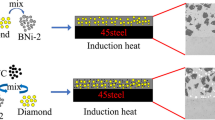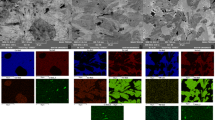Abstract
A factorial design approach technique was adopted to understand the high stress abrasive behaviour of a diamond reinforced composite coating for various compositions at different loads and abrasive sizes. A linear regression equation was developed and used for understanding the influence of the diamond concentration, applied load, and abrasive sizes on the wear response. A negative value of the coefficient associated with diamond concentration, together with its interactions with the applied load; suggest that the wear rate decreases with increasing diamond concentration. By contrast, a positive coefficient suggests an increase in wear rate due to an increase in related factors such as the applied load and abrasive size. The coefficients associated with the interactions of the parameters are insignificant by comparison with the individual parameters, thereby demonstrating that the interaction effect of these parameters towards the wear rate is insignificant. The wear rate may be extracted in terms of the diamond concentration, the applied load and the abrasive grit size using the above linear regression equation.





Similar content being viewed by others
References
Deutchman A.H., et al., (1989) Adv. Mater. Proc. 6:29
Neykova T., Kourtev J., Petrov I., Orlinov V. (1990) Bulg. J. Phys. 17:52
P.K. Bachman et al., Chem. Engg. News (1989) 24
Natishan P.M., et al., (1995) Mater. Sci. Engg. A197:79
K.E. Spear, J. Am. Ceram. Soc. (1989) 171
Rakhtenberg I.Sh. et al., (1995) Diamond Related Mater. (7):1020
Paredes R.S.C., Amico S.C., d’Oliveira A.S.C.M. (2006) Surf. Coat. Technol. 200:3049
Shipway P.H., McCartney D.G., Sudaprasert T. (2005) Wear, 259:820
E. Alakoski, Mirjami Kiuru, and Veli-Matti Tiainen, Diamond Related Mater. 15 (2006) 34
Venkateswarlu K. et al (2006) Mater. Sci. Engg. A 418:357
Hashmi S.A.R., Majumdar A.K., Chand N. (1996) J. Mater. Sci. Lett. 15:1343
Natrajan K.A. (1989) Trans. Ind. Inst. Met. 42:307
Singh R.J., Asthana S.N., Gunguly R.I., Dhindaw B.K. (1978) Trans. Ind. Inst. Met. 31:169
Mondal D.P., Das S., Rajput V. (2005) Mater. Sci. Engg. A 406:24
Mondal D.P., Das S., Rao R.N., Singh M. (2005) Mater. Sci. Engg. A 402:307
D.P. Mondal et al., 2nd Intl. Conf. Ind. Tribo (1999) 216
A.K. Ray, K. Venkateswarlu and L.C. Pathak, NML Tech. Report, SSP-0098, (2000) 1
Siniawski M.T., Harris S.J., Wang Q. (2003) Tribol. Lett. 15:359
Harris S.J., Krauss G., Siniawski M., Wang Q., Liu S., Ao Y. (2002) Wear 249:1004
Acknowledgments
The authors would like to thank Prof. S.P. Mehrotra, Director, National Metallurgical Laboratory, Jamshedpur for his kind permission to publish this paper. We also thank Mr. Manoj Kumar Gunjan for the SEM studies. Partial funding received from the Department of Science & Technology, Government of India, New Delhi is sincerely acknowledged. We are sincerely thankful to Prof. T.G. Langdon, University of Southern California, Los Angeles, USA for his invaluable help in correcting the manuscript.
Author information
Authors and Affiliations
Corresponding author
Appendix A
Appendix A
where i = 1–8, I is the trial number.
Rights and permissions
About this article
Cite this article
Venkateswarlu, K., Mohapatra, S., Rao, R.G. et al. High abrasive wear response of diamond reinforced composite coating: a factorial design approach. Tribol Lett 24, 7–14 (2006). https://doi.org/10.1007/s11249-006-9085-9
Received:
Accepted:
Published:
Issue Date:
DOI: https://doi.org/10.1007/s11249-006-9085-9




